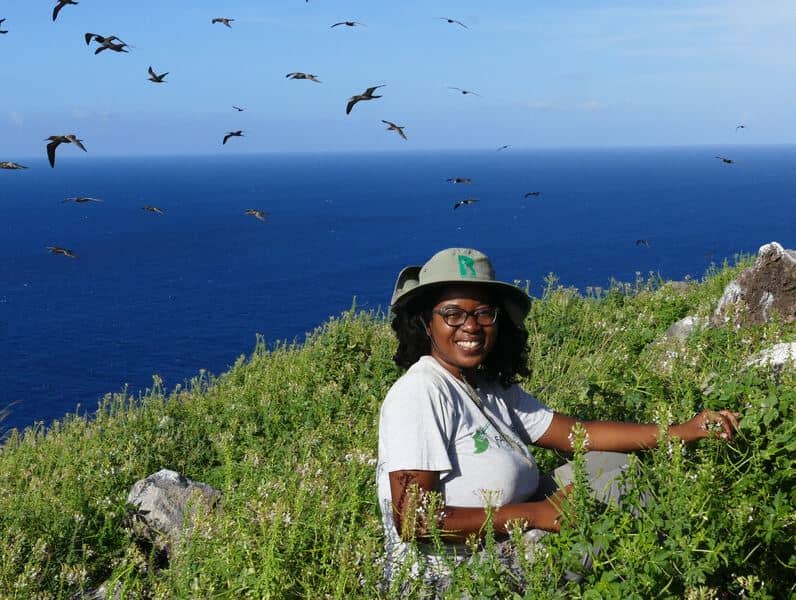

A Caribbean island that has transformed from a barren moonscape to a lush wildlife sanctuary in just a few short years has been made one of the biggest protected areas in the Caribbean.

The new designation is the result of the ongoing efforts of the government of Antigua and Barbuda, particularly the Department of Environment (DoE), and local and international conservation NGOs, including the Environmental Awareness Group (EAG), Fauna & Flora and Re:wild.
The new protected area – named the Redonda Ecosystem Reserve – covers almost 30,000 hectares of land and sea, including the entire island, its surrounding seagrass meadows and a 180 km2 coral reef.
Though largely unexplored, the new protected area is believed to contain at least 30 globally threatened and near-threatened species, along with globally important seabird colonies.

The designation follows the success of a major restoration programme launched in 2016 that has transformed Redonda from a barren landscape with the appearance of a ‘dusty moonscape’ to a thriving haven of biodiversity.
The first stages of the programme – led by EAG, DoE and Fauna & Flora with support from British Mountaineering Council and other leading conservation groups – primarily involved the removal of invasive species from the island, allowing native species to recover.
“The Department of Environment is very proud of our part in restoring Redonda, the third island of Antigua and Barbuda,” said Helena Jeffery Brown, Technical Coordinator in the Department of Environment, and founding member of the Redonda Restoration Programme.
“Now with the creation of the Redonda Ecosystem Reserve, we have made a great stride towards fulfilling our government’s commitment to conserve at least 30% of terrestrial, inland water and coastal and marine areas under the Kunming-Montreal Global Biodiversity Framework, adopted at the COP 15 of the UN Convention of Biological Diversity in December 2022.”
Following the removal of the invasive rats and feral goats in 2017, Redonda started to come back to life incredibly quickly.
Total vegetation biomass has increased by more than 2,000%, 15 species of land birds have returned and numbers of the endemic lizards have increased by more than fourfold.
In particular, the population of Redonda ground dragons – a critically endangered lizard – has increased by 13-fold since 2017.
To date, the restoration of this precious landscape has been truly remarkable,” said Johnella Bradshaw, Redonda Ecosystem Reserve Coordinator, EAG.
“So much hard work and dedication, from so many people, has gone into making the establishment of the Redonda Ecosystem Reserve possible – this designation will ensure we can continue rewilding the island to the beautiful, biodiverse environment it
once was.”
When Redonda was first documented by Europeans in 1493, it was, like many Caribbean islands, full of life, but European colonisers brought invasive species to the island, which over time destroyed its natural ecosystem.
Invasive rats preyed on native wildlife, and feral goats left behind by guano miners ravaged the plants.
Redonda’s unique species slowly disappeared and a number were driven extinct. As the vegetation disappeared, soil and rocks slid into the sea, smashing and choking the coral reefs surrounding the island.
Since the removal of the invasive species, Redonda has seen a spectacular recovery, with thousands of native trees taking root and anchoring the soil, seabirds returning to nest in greater numbers and many native animal and plant populations rising exponentially.
Restoration work is still ongoing, however, and EAG, Fauna & Flora, Re:wild and partners are working together on a range of actions to support the island’s biodiversity, including implementing biosecurity measures to limit the risk of any reinvasions, monitoring the recovery of native species, conducting marine monitoring and surveillance, promoting sustainable fishing, and planning the reintroduction of native species that cannot find their own way back to the island, such as iguanas and burrowing owls.
“The Caribbean Islands are facing the highest extinction rates in modern history, and the restoration and protection of areas like Redonda are critical,” said Jenny Daltry, Caribbean Alliance director for Re:wild and Fauna & Flora.
“While the removal of invasive species has been key to Redonda’s revival so far, that’s by no means the end of the story.
The protected area designation is vital for our ongoing commitment to restoring Redonda to its former glory, and could pave the way for Redonda to become an incredible sustainable tourism attraction in the near future.”
CLICK HERE TO JOIN OUR WHATSAPP GROUP
CLICK HERE TO JOIN OUR WHATSAPP GROUP
Advertise with the mоѕt vіѕіtеd nеwѕ ѕіtе іn Antigua!
We offer fully customizable and flexible digital marketing packages.
Contact us at [email protected]














Thank you guys for your sterling efforts at restoring and maintaining our biodiversity.
Devils bridge and the surrounding area is also listed as a protected area..yet the area has been violated by the verandah/hammock cove resort.
Comments are closed.